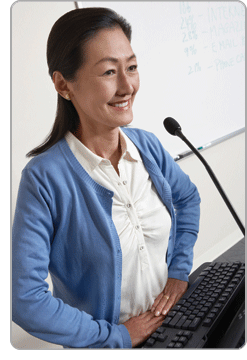


Asian women speak out on “Speaking
Up.”
Supplied by Corin Ramos
Born and raised in China, Yun Li was only 25 years
old when she came to America nearly 20 years ago. Like many immigrants,
Li worked hard to achieve her American Dream. For Li this included
learning English, earning a Ph.D. in physics and establishing a
successful career in the high-tech industry.
Despite her accomplishments, Li felt hindered by what she called “a
language and speech handicap.” She also had been thinking about leaving
her high-tech life to answer her inner calling of helping people as a
life and business coach, a vocation that required her to overcome her
fears and anxieties about public speaking.
To improve her speaking skills, Li joined a local Toastmasters club in
Albuquerque, New Mexico, four years ago. At the time, she was the club’s
only Asian female member, and common misperceptions about Asian women
quickly posed a challenge for the self-proclaimed “recovering
physicist.”
For one thing, she felt insecure because of her accent, and members
frequently corrected her grammar as well. “People thought I wasn’t smart
or educated because I spoke differently,” she says.
Her friendly personality also seemed to work against her. “I smiled a
lot, which made people think I was passive and not as serious or
ambitious as other Western business women.”
Li’s experience is common for many Asian women, even those born and
raised in the United States, according to Helen Hsu, a licensed clinical
psychologist and international speaker on bicultural and Asian American
issues.
“Asian women are stereotyped as being shy, passive and submissive;
therefore, they may be seen as followers and not leaders,” explains Hsu.
“Many Asian women also face assumptions that if they speak with an
accent, then they must not be articulate.”
On the other side of the coin, even those without an “accent” are not
immune to such remarks. Hsu, who was born in the U.S. and worked as an
English writing tutor while acquiring advanced degrees, says she still
is asked how it is that she speaks “without an accent.”
“The enduring popularity of these stereotypes does have a negative
impact on young Asian girls and women,” says Hsu. “They tend to be
treated as ‘outsiders,’ as if they are foreign workers or recent
immigrants rather than authentic Americans.”
The public speaking arena, where Asian women still are a rarity, poses
additional challenges. “Stereotypes can contribute to anxiety,” Hsu
says, “and an Asian female speaker may find that she has to make an
extra effort to establish credibility. First impressions do matter, and
an Asian woman has more negative stereotypes to overcome or disprove
when she speaks in public.”
“I have to work a lot harder to break
down stereotypes and biases. Some presentations are like pulling a
two-ton suitcase up a steep mountain.” – Yoon Cannon
That’s not news to Yoon Cannon, a 38-year-old, Korean- born business
coach and speaker based in Philadelphia who often speaks in front of
“older, male Caucasian” business owners. “I have to work a lot harder to
break down stereotypes and biases,” Cannon says. “Some presentations are
like pulling a two-ton suitcase up a steep mountain.”
Establishing Credibility
Michael Soon Lee, author of Cross-Cultural Selling for Dummies,
and the first Asian American Certified Speaking Professional, advises
Asian female speakers to establish their credibility “the moment you
walk out on the platform.”
“Because of these stereotypes of Asian females, it’s important to
overcome that stereotype and connect with the audience immediately,
especially when speaking to predominantly male audiences,” Lee advises.
In one of her presentations, Yoon Cannon established that connection by
telling her own story as a business owner. “Even if I’m Asian, female
and at least 15 years younger than most of the audience members, we
could all relate to the same struggles and challenges of business
ownership,” Cannon says. “Throughout the presentation, I could feel
their interest and energy growing steadily.”
Clint Cora, an author and speaker who has coached many Asian females in
speaking before Western audiences, has this advice: “Loosen up, speak up
and don’t be so self-conscious when speaking.” She says female Asian
speakers tend to have very soft voices. “This not only reinforces those
negative stereotypes of being passive and submissive, but it makes it
difficult for audience members sitting in the back of the room to hear
you!”
Cannon agrees. “Don’t be afraid to have strong stage presence. You don’t
want to be perceived as a delicate mouse.”
Cultural Juggling Acts
Despite these difficulties, Asian women are continuing to overcome these
barriers and embrace public speaking. They also have learned to tailor
their presenta- tions when speaking before non-American audiences
abroad, which can pose a whole new set of “rules” and challenges.
Based in Singapore, Bennett Porter is head of marketing for Yahoo!
Emerging Markets. Half Caucasian and half Asian, she has been speaking
in Asia since mid-2006 to seasoned, older executives (both male and
female) as well as twentysomethings who are new to the industry.
“I love telling stories,” says Porter. Although she ends up taking most
of the humor out of her presentations (“because of the language issue”),
she says she can’t recall any negative experiences due to her gender or
ethnicity. “Asians go out of their way to be nonconfrontational, so even
Q&A can sometimes be light.”
A frequent speaker on cross- cultural leadership in China and other
countries, Helen Zhang can relate to Porter’s experience when speaking
to a more subdued Asian audience. Based in Beijing, China, Zhang is the
founder of China Time, Inc., which advises both Chinese and foreign
corporate leaders on business strategies.
“When speaking in front of Chinese audiences in China, I adjust my own
expectations and style of delivery,” says Zhang, author of the book
Think Like Chinese. “Chinese audiences are often reserved, polite
and would not ask many questions – if at all. They prefer to write down
their questions, then pass them forward to remain anonymous. They don’t
want to lose face or speak out in a crowd.”
Yao-Hui Huang also has a special perspective when it comes to speaking
to Asian audiences versus those in America. Based in New York, Huang is
founder of The Hatchery, a venture collaboration organization, and is a
frequent flier to Asia, where she leverages business deals between
companies there and in America.
“With American audiences I tend to be more dynamic,” says Huang. “With
Asian audiences, I tend to emphasize a teaching persona because Asian
audiences are more studious in their approach.
“Asian audiences are tougher audiences because they often have more
perceived personal obstacles to overcome and may not accept the ease by
which I offer advice and solutions to problems. I tend to begin my talks
with humor, and carry the weight of the presentations with case
studies.”
Yoon Cannon performs a similar cultural juggling act. When speaking to
Asian audiences, especially women in their 20s to young 30s, Cannon says
she has “a lot more fun with bringing out the bolder side” of her
personality.
“However, if I am speaking to a more culturally traditional and older
Asian audience, I am careful to present myself and my perspectives in a
more conservative tone, and make sure I cross all my t’s and dot all of
my i’s in terms of Asian etiquette,” she says.
Yingdan Liu, who is this year’s District 85 Lt. Governor Education and
Training from Shanghai, China, says the biggest difference between
speaking in the U.S. and in China is “the confidence, passion and
enthusiasm” demonstrated by American speakers.
“Americans are much more expressive than the Chinese,” she says. “When
Americans use big facial expressions and exaggerated body language, it
looks natural. But as an Asian woman, I don’t have much expression on my
face, and I won’t use body language. Also an American audience will
laugh very loudly, but I don’t want to laugh too loudly, to influence
the people around me to – just chuckle, or use my hand to cover my
mouth.”
‘Be Yourself’
Cultural juggling act aside, the speakers agree on one main
point: “Be yourself.”
For Zhang, this means not making a major issue of gender or ethnicity.
“It is who you are and what you are about to say that
really matter.”
“Just be you,” echoes Yun Li. “When I pretend to be someone else, it’s a
disaster.”
For Li, taking her own advice and sticking with her club has paid off.
In 2007, she gave in to her inner calling and founded Yunexis, which
provides consulting, coaching and training services to organizations,
businesses and individuals. She speaks in public regularly, and loves
it.
Last year, she became club president, and often touts the benefits of
joining Toastmasters. Despite the cultural barriers and off-base remarks
of the past, Li said she was made welcome by club members. Most
importantly, it gave her the opportunity to practice public speaking,
which she now describes as “fun and very interactive!”
Cannon says she is always aware of her gender and ethnicity, but it just
makes her that much more motivated to deliver stronger content. The
payoff? “It’s always a great feeling to know you made a positive impact
on people and that they appreciated it.”
As with all public speaking, practice is key, regardless of gender or
ethnicity of the speaker, says Helen Hsu, the clinical psychologist. Her
advice to female Asian speakers can help anyone who wants to enjoy a
more powerful speaking presence:


